Fond, furry farewells There’s a burgeoning local sector of support focused on providing end-of-life care needs for pets and their owners
Read this article for free:
or
Already have an account? Log in here »
To continue reading, please subscribe:
Monthly Digital Subscription
$1 per week for 24 weeks*
- Enjoy unlimited reading on winnipegfreepress.com
- Read the E-Edition, our digital replica newspaper
- Access News Break, our award-winning app
- Play interactive puzzles
*Billed as $4.00 plus GST every four weeks. After 24 weeks, price increases to the regular rate of $19.00 plus GST every four weeks. Offer available to new and qualified returning subscribers only. Cancel any time.
Monthly Digital Subscription
$4.75/week*
- Enjoy unlimited reading on winnipegfreepress.com
- Read the E-Edition, our digital replica newspaper
- Access News Break, our award-winning app
- Play interactive puzzles
*Billed as $19 plus GST every four weeks. Cancel any time.
To continue reading, please subscribe:
Add Free Press access to your Brandon Sun subscription for only an additional
$1 for the first 4 weeks*
*Your next subscription payment will increase by $1.00 and you will be charged $16.99 plus GST for four weeks. After four weeks, your payment will increase to $23.99 plus GST every four weeks.
Read unlimited articles for free today:
or
Already have an account? Log in here »
Hey there, time traveller!
This article was published 24/11/2023 (706 days ago), so information in it may no longer be current.
Franki, it was the privilege of our lifetimes to care for you and to call you family.
Velcro, you came by your name honestly as you never came in without a leaf, twig or acorn stuck to you! What you really did though was stick to our hearts.
Beau, I was never lonely with you.
The hundreds of obituaries posted to Sunset Veterinary Care’s website are accompanied by photos of cats lounging happily in sunbeams and dogs panting exuberantly next to their favourite toys.
Each entry, brimming with love and gratitude, is an example of the revered position pets hold in many households today. Each entry captures an innate truth about the life and death of companion animals: to know unconditional love — be it from a cat or a dog or a cockatoo — is to know a universal kind of pain.
The site’s very first post is in honour of Tiger, a cuddly tabby with a fondness for chin scratches and a penchant for stealing taco chips.
RUTH BONNEVILLE / WINNIPEG FREE PRESS Winnipeg veterinarian and founder of Sunset Veterinary Care Elizabeth Andree at home with her dog, 14-year-old Jack.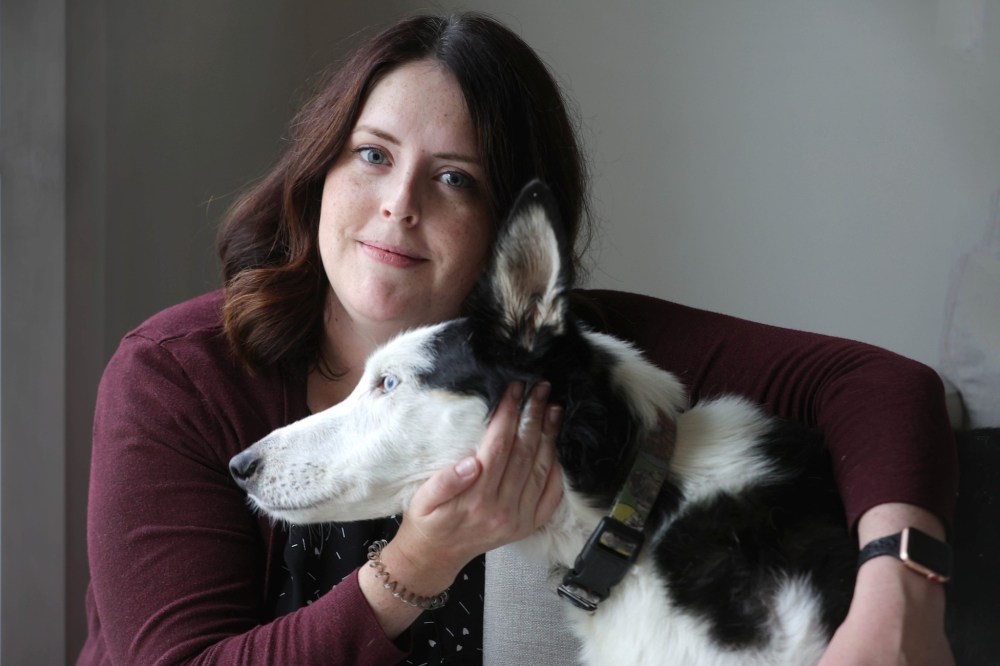
She is the late sidekick of Elizabeth Andree, a Winnipeg veterinarian and the founder of Sunset. Tiger’s death from cancer at nearly 15 years old, and the overwhelming grief that followed, inspired Andree to build a private practice focused on end-of-life care for pets.
“I was really motivated by my own emotions,” she says. “If I felt this strongly about losing a pet, then there are probably a lot of other people that feel the same way. And I really wanted to be able to help with the skills that I have.”
Andree is far from the only one with strong feelings about their pets. Humans and animals have been co-habitating for thousands of years. Contemporary research into the human-animal bond suggests pets have a beneficial impact on their owners’ mental, social and physical well-being.
Pet ownership is on the rise globally largely due to dropping fertility rates and increasing household incomes over the last several decades. In recent years, this trend has been spurred on by everything from pandemic isolation to the prominence of pet influencers on social media, leading to a significant shift in the way domestic animals are regarded in society today.
“I was really motivated by my own emotions … If I felt this strongly about losing a pet, then there are probably a lot of other people that feel the same way.”–Elizabeth Andree
In her book, Just Like Family: How Companion Animals Joined the Household, American sociologist Andrea Laurent-Simpson describes pets as “significant others, recognized actors who, in concert with their humans, have the capability to transform family structures.”
The emergence of what Laurent-Simpson calls “multi-species families” — in which pets share equal status with human family members — is connected to major demographic changes that have been impacting the makeup of family units since the 1970s. As the idea of a traditional nuclear family has dissolved, more people have taken to treating companion animals as children and peers.
With pets now occupying a starring role in our lives, the handling of their deaths has undergone a similar transformation.
When Andree attended veterinary school a decade ago, dealing with death wasn’t a major part of the curriculum.
“I definitely had many, many more hours learning about cow nutrition than I ever did learning about euthanasia,” she says, adding that euthanasia is one of the most common medical procedures performed in most vet clinics. “It is unfortunate that it wasn’t as highly focused on in our education.”
After Tiger died, she completed a certification in hospice and palliative care for companion animals. In 2020, she left her job at a local clinic and launched Sunset with the goal of providing comfortable, dignified goodbyes for pets and owners alike.
Supplied Andree decided to focus on end-of-life care for pets after the death of her cat Tiger.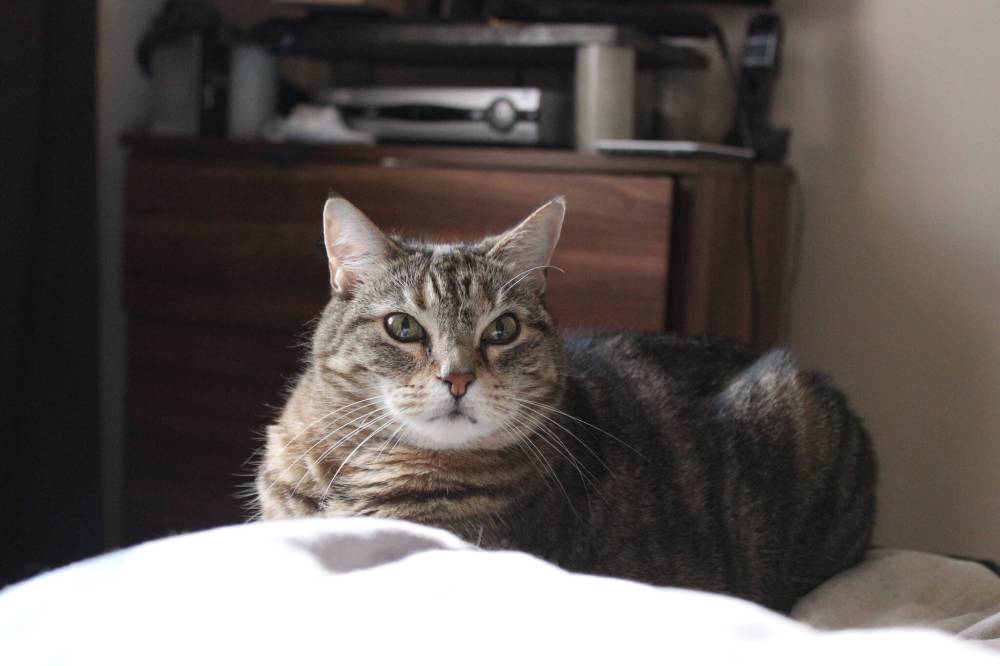
Sunset specializes in in-home euthanasia. There are three vets on staff, including Andree, who spend their days making house calls for aging and ailing animals and, when the time comes, administering life-ending medications in living rooms, backyards and other beloved domains.
The remote clinic primarily works with cats, dogs and the occasional rabbit. Over the last three years, Sunset has served more than 1,000 families in Winnipeg. Andree believes there’s growing demand for end-of-life care beyond what most veterinary offices are able to provide.
When Tiger’s quality of life started to decline, Andree brought her into the clinic where she was working at the time. The journey to and from the appointment was a difficult one.
“I feel like she did have a peaceful passing, but she was not a fan of car rides,” Andree says. “And then my husband and I had to drive home afterwards (without her) and that was really hard.”
Familiarity, privacy and time are a few of the benefits of in-home euthanasia, she says.
At Sunset, the goal is to make the process as stress-free as possible. After scheduling an appointment by phone or email, clients receive a package outlining how the day will unfold and ways to prepare for the procedure.
“People have a lot of anticipatory grief, they’re really in their head about how sad they’re going to feel or what they’re going to be missing without their pet.”–Elizabeth Andree
Ahead of the visit, Andree recommends working through a pet-friendly bucket list — one last stop at a favourite park, a decadent final meal, time spent with a cherished toy or companion, for example.
On the day of, it can be helpful to create a calm environment by dimming lights, playing music and offering a comfortable place for the pet to lie down. Treats don’t hurt.
The suggestions are as much for the animals as they are for the owners.
“I don’t think we ever truly feel ready,” Andree says of the decision to put down a pet. “The most challenging part is preparing families. People have a lot of anticipatory grief, they’re really in their head about how sad they’re going to feel or what they’re going to be missing without their pet.”
The procedure itself is a two-step process. Andree first administers a strong sedative to induce a sleep-like state. Families are then given the opportunity to say their final goodbyes and retrieve any keepsakes they may want, such as locks of fur or paw-print impressions.
After the euthanasia medication is injected, clients are again offered time to sit with their pet before the body is taken away for cremation or burial. While the medical side of things only takes about 20 minutes, appointments can last as long as two hours. At home, there’s no need to rush.
“We’re not worried that we need this room or this space for anything else,” Andree says. “This is just for them.”
Grief is not a monolith and people react to the death of their pets in different ways. Another benefit of in-home euthanasia, Andree says, is the freedom of expression it allows.
“People seem to grieve a lot heavier when they’re at home,” she says. “In clinics, I think a lot of people hold back tears and emotions. Families are definitely much more open to crying and expressing themselves when they’re in their own space.”
As an animal lover who interacts with grieving humans day after day, Andree also takes time to protect her own mental health. Her appointments are intentionally spread out to allow for emotional processing, a bite to eat and a moment alone. Then, it’s on to the next living room and the next goodbye.
“We have to care for ourselves first, so we can continue to do what we do,” she says.
Save for the bubbling of a large, pristine fish tank, the viewing room is quiet and sedate. There’s a pensive photo of a misty highway on one wall and a shelf of multicoloured urns and small boxes on the other. A plush blanket lies in wait on top of a long counter next to a framed poem entitled, My Forever Pet.
The pall is lifted when Kevin McIver enters.
“So, what do you wanna see?” he asks enthusiastically, wearing a hoodie and holding a can of sparkling water.
McIver is a director of Precious Pet Cremation, a family-run business founded by his parents, Iain and Connie McIver, in the late 1980s.
RUTH BONNEVILLE / WINNIPEG FREE PRESS Precious Pet Cremation co-owner Kevin McIver with one of the business’s incinerators. The family-run operation in the RM of Rosser was founded by his parents, Iain and Connie McIver, in the late 1980s.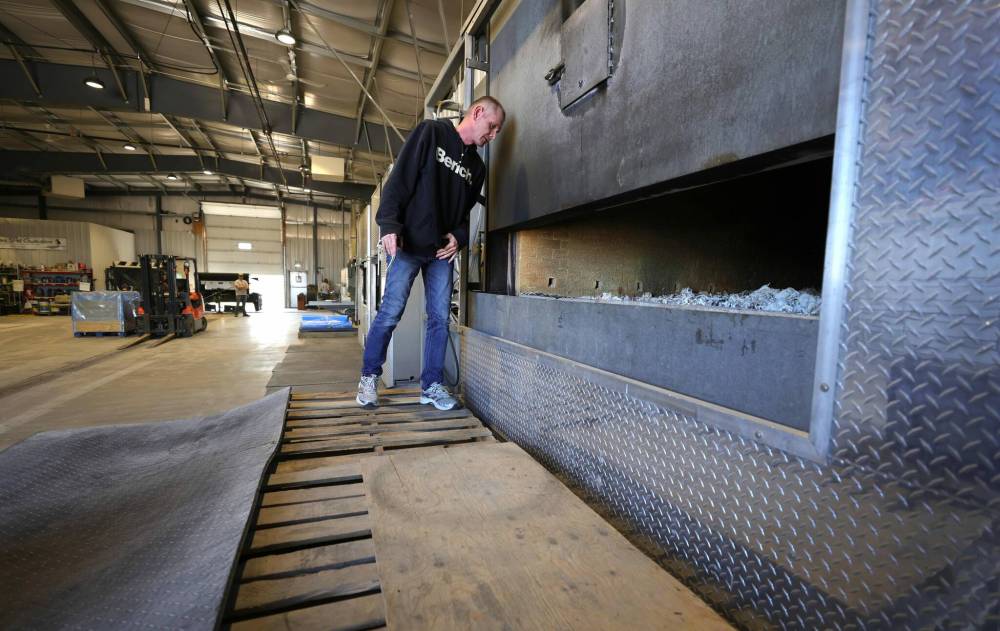
The crematorium is located on a spacious treed lot at the corner of the Perimeter Highway and Selkirk Avenue in the Rural Municipality of Rosser. When the McIvers purchased the property, they took over the existing kennel and pet boarding business, renaming it Santana Kennels. They added cremation services after discovering a working incinerator on the grounds.
“We approached a couple of vet clinics in the city and asked them if they’d be interested in offering their clients cremation as aftercare,” McIver says. “It wasn’t as mainstream then, but pets didn’t mean the same things 30 years ago that they mean to people now.”
RUTH BONNEVILLE / WINNIPEG FREE PRESS A dog tag is removed from an animal before final processing.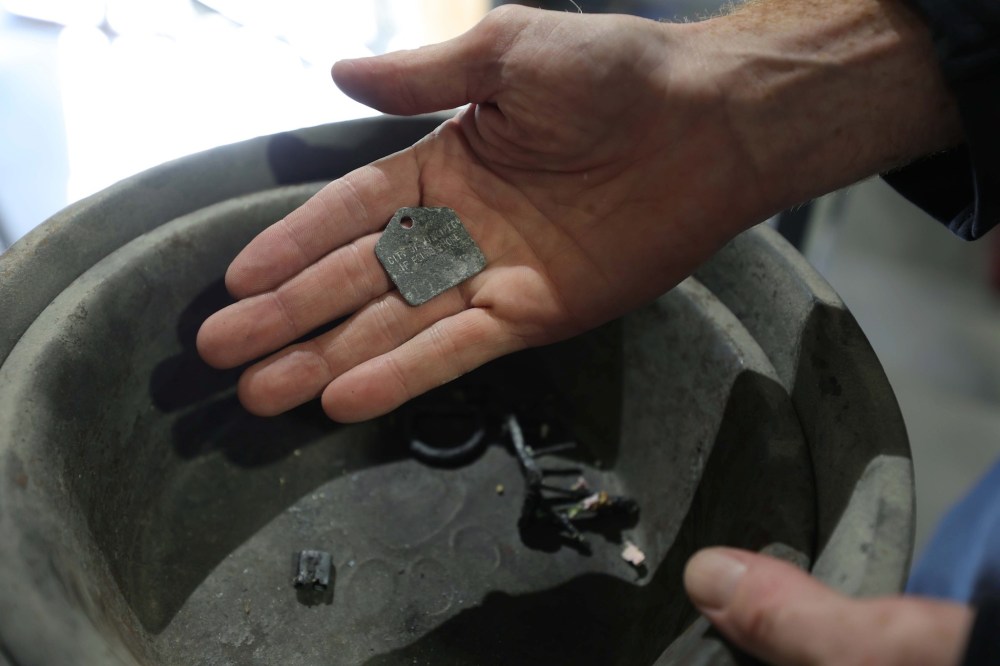
While it is legal to bury a dead pet on private property in Winnipeg — provided the remains are placed at a sufficient depth to avoid odours — the rules vary by jurisdiction. Cremation has become the standard practice and Precious Pet has become one of the province’s main providers.
The business has grown out of demand and circumstance. In 2003, Santana Kennels suffered an extensive fire originating from the stack of the crematorium. Iain was described as “an absolute hero” in Free Press coverage of the event after rescuing more than 60 cats and dogs from the blaze. There were no casualties.
The kennels were rebuilt and remained operational until earlier this year, when staffing became an issue. The crematorium has expanded to include two viewing rooms, a cremain processing office and a separate outbuilding housing six incinerators. Today, Precious Pet works with more than 100 vet clinics between Yorkton, Sask., and Thunder Bay, Ont., and conducts thousands of cremations annually.
While their parents are still involved, McIver and four of his five siblings handle many of the day-to-day operations. It’s a career he was practically born into.
“I’ve worked in this kennel and in cremation since I was 10 years old,” McIver says proudly.
RUTH BONNEVILLE / WINNIPEG FREE PRESS A Precious Pet Cremation worker with some of the tools of the pet-cremation trade. 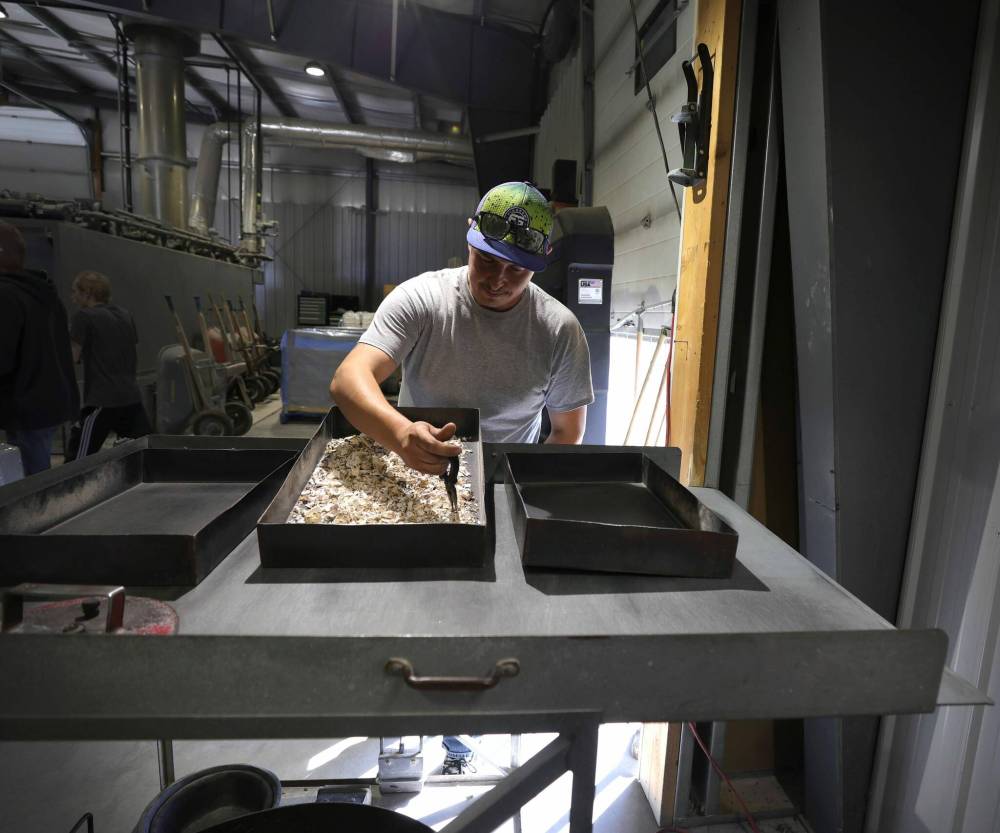
He’s full of fascinating stories from a profession most people would rather not think about — such as the time he had to figure out how to cremate a client’s beloved pet tarantula.
As a passionate student of cremation science, he’s also full of nitty-gritty facts about incinerator temperatures and the amount of ash produced by different animals, facts he dispenses freely while touring the Free Press around the grounds.
While these are not the kinds of anecdotes he shares with grieving members of the public, clients are allowed a certain amount of access to the facilities. Precious Pet offers witness cremations — at specific times and with enough notice — during which families can watch and even participate in the act of cremating their pet.
RUTH BONNEVILLE / WINNIPEG FREE PRESS Precious Pet offers private cremations with the remains returned in a special urn or an ornate box.
“I even give people the option to press the start button on the machine to really feel like part of the process,” McIver says, adding that the service was created in response to a widely publicized case of mishandled remains at a local pet crematorium a number of years ago. That facility has since closed.
“For some people it’s mistrust, for some people it’s closure and for some it’s just curiosity,” he says. “Either way, we want to give you closure, we want you to feel — in a crappy situation — the best you possibly could. You just lost a family member.”
McIver can relate to the people who arrive at the door with a deceased animal in their arms. As a lifelong pet owner, he knows exactly how that moment feels. Last year, he cremated his own Pomeranian — an experience he felt privileged to partake in.
“You can find something comforting in something uncomfortable,” he says. “I think we’re a testament to that.”
Precious Pet offers private cremations for those who would like to keep their pet’s ashes. In those cases, one animal is cremated at a time and their remains are returned in a special urn or an ornate box.
With communal cremations, multiple animals are processed at once. Their ashes laid to rest in the wild prairie field that extends behind the facility and into the horizon line.
While staff at Sunset and Precious Pet deal intimately with death, they don’t specialize in the emotional toll of pet loss.
That’s where Rona Johnston comes in.
Johnston is a warm and engaging conversationalist. Her voice has a sing-song quality that makes the distance of a phone line evaporate. Although, she doesn’t do a lot of talking while volunteering with the Winnipeg Humane Society’s Pet Loss and Grief Support Line. Listening is often her main priority.
“Usually, the loss has been recent and they want to talk about it,” she says. “People are extremely willing to share when they’re that vulnerable, so it’s a lot of active listening.”
RUTH BONNEVILLE / WINNIPEG FREE PRESS Rona Johnston is a volunteer with the Winnipeg Humane Society's Pet Loss Support Line. She offers grief counselling and a kind ear to callers who have lost a pet.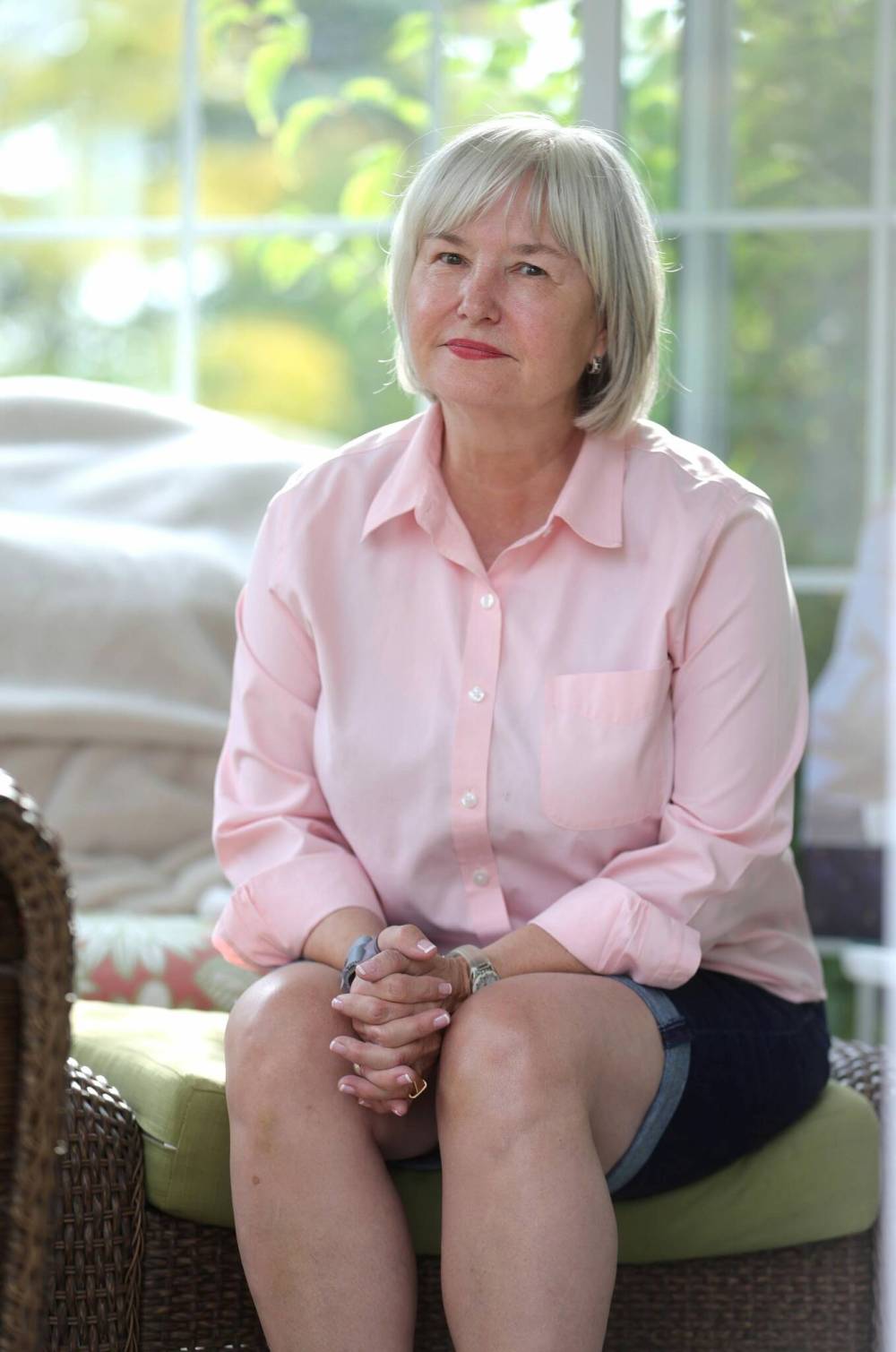
The Humane Society has been offering pet loss services for roughly 15 years. The phone line launched eight years ago and was born out of a monthly in-person support group for bereaved pet owners. It’s the only service of its kind in Manitoba and one of few in North America.
“We’ve had people from Florida call us, from British Columbia,” Humane Society foster and volunteer director Kelle Greene says. “It’s definitely a unique service we’re providing.”
The program averages about 100 calls per year and is managed by a crew of four volunteers with specialized grief counsellor training from Klinic Community Health. The goal is to provide a safe space, free of stigma, for callers to process the wide range of emotions in the wake of a loss.
“Often, human families or support systems don’t have an understanding of what someone’s going through when they’ve lost their pet,” Greene says. “The bond that you have with an animal is so strong and when it’s gone, it’s helpful to have someone just validate your feelings.”
Johnston started volunteering with the Humane Society as a “cat cuddler” and adoption assistant — a surprising about-face for someone who grew up with a strong dislike of felines. Dogs were more her style, but taking care of a friend’s cat changed her perspective.
“I got to like their stupid cat,” she says, laughing. Johnston has since had four cats of her own, one of whom she credits with helping her cope with the recent death of her husband.
“Often, human families or support systems don’t have an understanding of what someone’s going through when they’ve lost their pet.”–Kelle Greene
Her own experience as a pet owner comes up occasionally in conversations with callers to the support line. At all times, it informs her empathy.
Johnston graduated from cat cuddler to grief worker in 2015. She previously volunteered with Klinic’s crisis line as a crisis phone counsellor and was eager to apply those skills in a new context.
The Humane Society’s pet loss support line (204-988-8804) isn’t a 24-hour operation. Callers are invited to leave a voicemail outlining their situation and a volunteer will respond as soon as possible.
Johnston, a retired project manager, is responsible for handling the line one week at a time. Her shifts take place at home, where she responds to messages and takes on the role of adviser or sympathetic listener based on the needs at the other end of the phone.
Sometimes callers want to work through the difficult decision of putting down a pet or the logistics of dealing with their remains. Other times they’re interested in storytelling and reminiscing. Often, they’re looking for a conversation that doesn’t diminish their sadness.
“It’s a privilege to talk to other pet owners … To hear the impact that this animal has made on their lives is really quite incredible.”–Rona Johnston
“We’re still not a society that’s comfortable with loss, period,” she says. “Some people will hear from their family or friends, ‘Well, it’s just a pet, it’s just a dog, just a cat — get over it.’
“They value that critter so much and they’re experiencing the same steps in the grief process as when you lose a friend or a human being.”
Johnston works to assure callers that their grief is normal. She also keeps her ears tuned to signs of unhealthy coping. If concerns about mental or physical safety arise, she’ll refer them to a doctor or additional resources.
Over the last eight years, Johnston has talked to people from all walks of life. Some are frequent flyers, others call once and move on. No two pet owners are alike. And yet, the death of a beloved companion can evoke common feelings of sorrow and guilt, anger and frustration.
For Johnston, helping others process those emotions is deeply satisfying work.
“It’s a privilege to talk to other pet owners,” she says. “To hear the impact that this animal has made on their lives is really quite incredible.”
Those are also Tesia Rhind’s favourite kinds of stories. The Winnipeg tattoo artist specializes in hyper-realistic designs in shades of black and grey. Animals have been a focal point from the beginning.
“I was being commissioned to draw people’s pets a lot and that actually led me into the path of tattooing,” she says. “So I just kept doing them.”
Rhind has done hundreds of pet tattoos to date, some as a memorial and some as a living tribute. The fine line portraits are often framed by sprigs of foliage and flowers. At least one features a retriever standing in a kiddie pool surrounded by a sparkling ring of hot dogs — a brief glimpse of doggy heaven.
Her goal with every pet portrait is to capture the essence of the animal’s personality.
“I always tell people if they want a portrait of their dog, it’s gonna take a little bit longer because I want to get it exactly right,” she says. “I want them to feel like (their pet) is there with them.”
Richard Padua photo Tesia Rhind is a Winnipeg tattoo artist who has carved out a niche in permanent pet portraiture.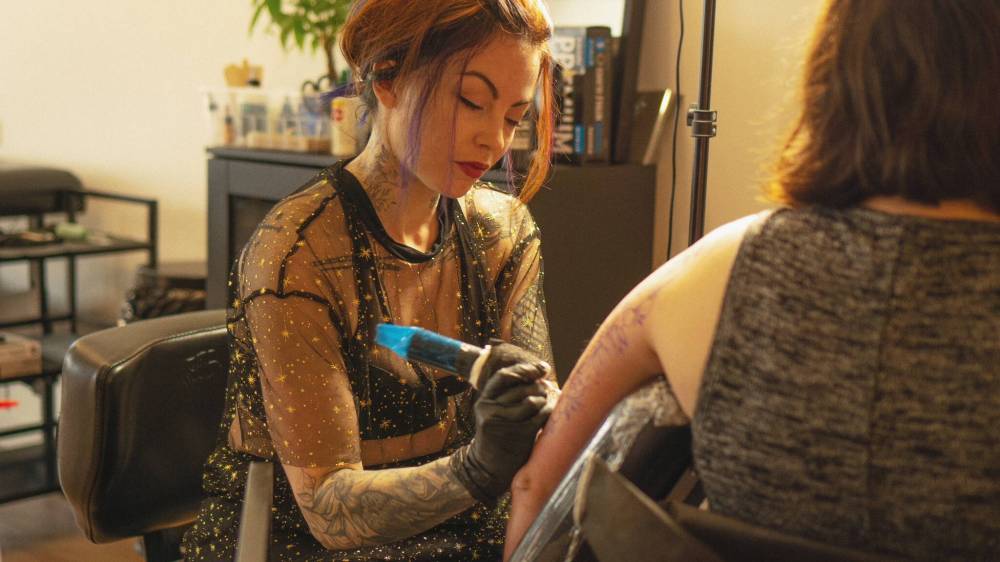
To get it “exactly right,” she asks for evocative reference photos and biographical details. During tattoo sessions, clients often relay stories about their pets.
“People have told me about how the animal has literally saved their lives just by providing them with so much joy and love,” Rhind says, adding that while the painful process of getting a tattoo can be cathartic, she’s careful about prodding too much if the loss is fresh.
“I don’t want to make people sit there and hurt while I’m tattooing them and also cry while thinking about their animal.”
Pet portraits, she’s found, are often the subject of first tattoos. They’re a meaningful keepsake and an easy introduction to the art form. “There’s not going to be much regret with getting a tattoo of something you love so much,” she says.
Christine Klassen has zero regrets about the forearm sleeve she commissioned from Rhind this year of her late dog Lucy and her living dogs Sam and Archie.
MIKAELA MACKENZIE / WINNIPEG FREE PRESS Christine Klassen with Sam and Archie. After Klassen’s dog Lucy died, she got a tattoo to memorialize her longtime companion. 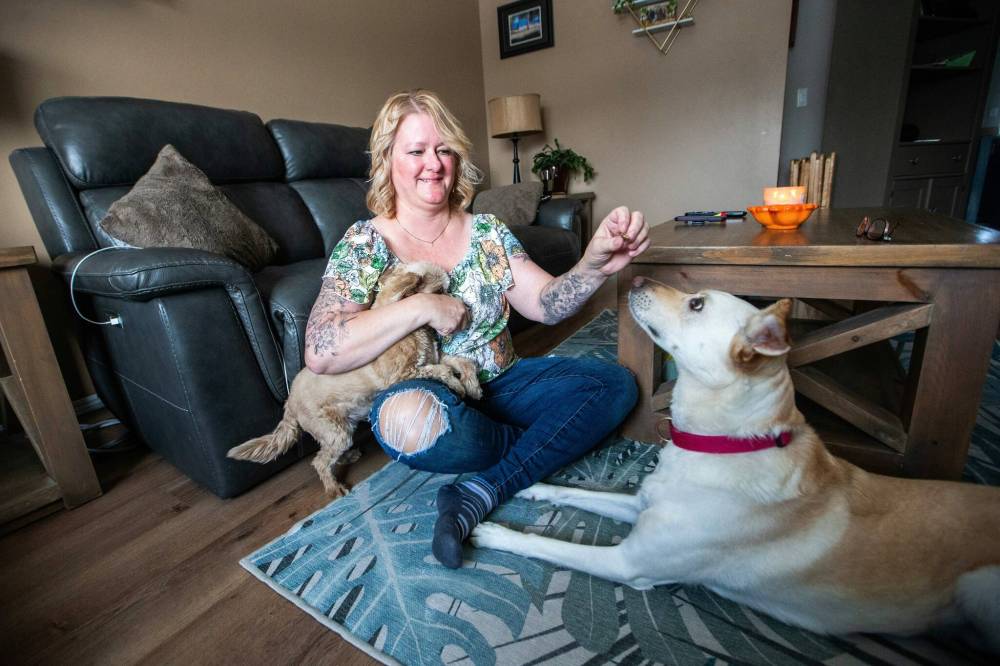
Lucy was a Labrador retriever mix with a gentle demeanour and an innate love of water. If there was a creek nearby, she was in it. Lucy was also something of an escape artist who made lots of friends during solo trips around the neighbourhood.
“Wherever her nose took her is where she went,” Klassen says. “She was an amazing dog.”
When the family adopted Lucy from the Humane Society in 2007, she had just given birth to a litter of puppies. It was assumed she was seven years old at the time, which, if correct, would mean she was the ripe old age of 22 when she died last December.
MIKAELA MACKENZIE / WINNIPEG FREE PRESS Klassen's pet tattoo of Lucy, who she says had a gentle demeanour and love of water.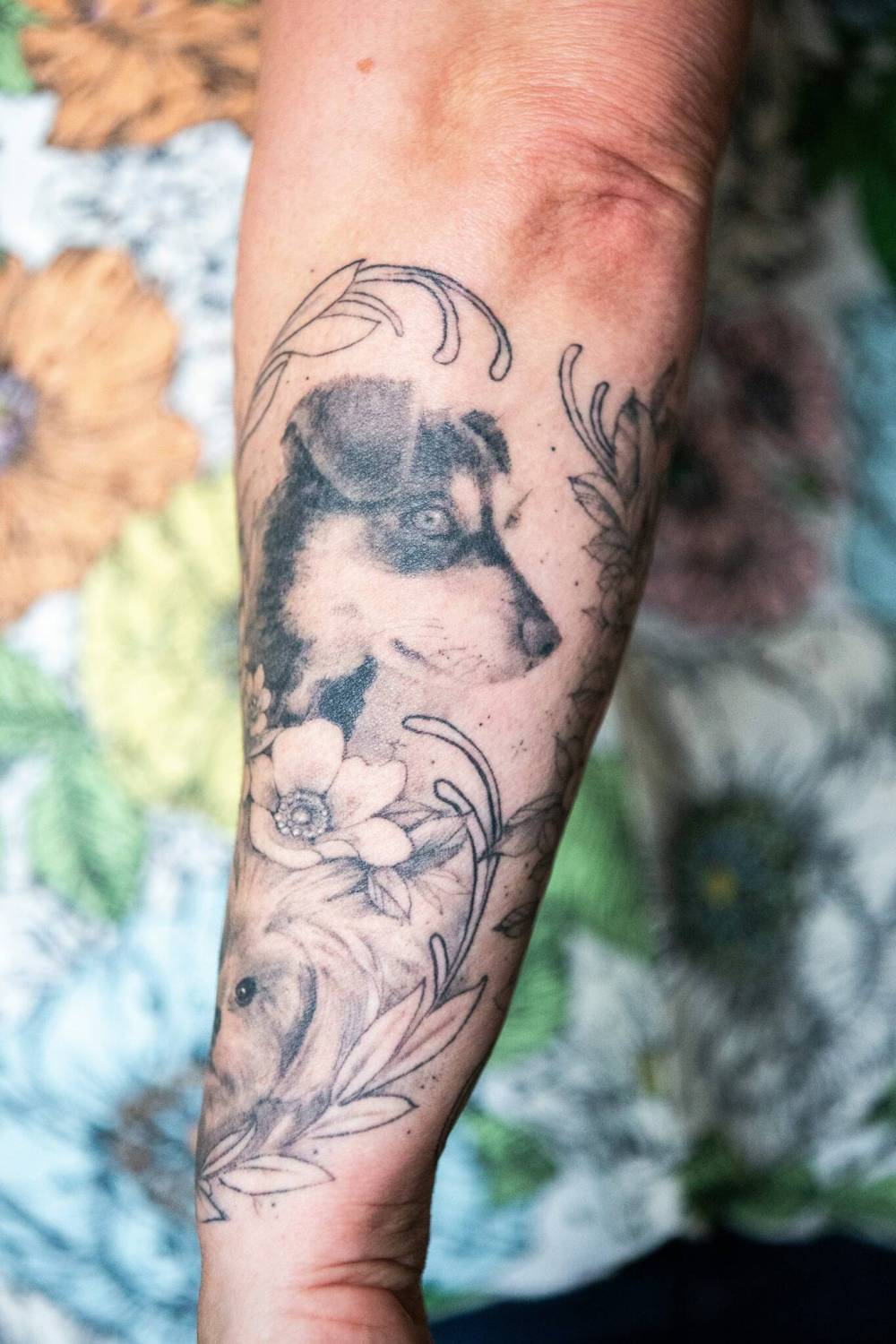
Lucy was a constant calming presence during many milestones in Klassen’s life. The decision to put her down, despite her declining health and faculties, was a difficult one made slightly easier through in-home euthanasia.
“I still didn’t know if I was ready to give her up,” she says, recalling the visit from Sunset Veterinary Care with a catch in her throat. “It was just time and it was the sweetest thing. We had Lucy laying on her dog bed, the vet was doing her thing and my other two dogs laid beside her during the process.
“It was very peaceful, I would never do it any other way.”
In the months that followed, Klassen knew she wanted a permanent reminder of her longtime companion. She already had one tattoo from Rhind — a tribute to her late grandfather — and was eager to get more ink.
“I absolutely wanted to be able to see her every day,” she says, adding that Rhind captured Lucy masterfully.
Klassen is a palliative care nurse. In the year since Lucy’s death, the tattoo — which wraps around her lower arm, accented with flowers and filigree — has become a connective bridge with patients, many of whom have had to say goodbye to their own pets upon entry into hospice care.
“Daily, I get comments and questions from my patients about my tattoos,” she says. “It presents opportunities to not only talk about Lucy, but also about their own losses, their own pets.”
While Klassen still misses her dog deeply, the skin-deep memorial has made it easier to mourn the loss. Lucy is always present — through a glance at her wrist or in passing conversation.
“I’m keeping her memory alive,” Klassen says.
eva.wasney@winnipegfreepress.com
X:@evawasney

Eva Wasney has been a reporter with the Free Press Arts & Life department since 2019. Read more about Eva.
Every piece of reporting Eva produces is reviewed by an editing team before it is posted online or published in print — part of the Free Press‘s tradition, since 1872, of producing reliable independent journalism. Read more about Free Press’s history and mandate, and learn how our newsroom operates.
Our newsroom depends on a growing audience of readers to power our journalism. If you are not a paid reader, please consider becoming a subscriber.
Our newsroom depends on its audience of readers to power our journalism. Thank you for your support.
History
Updated on Friday, November 24, 2023 5:09 PM CST: Corrects name of kennel company.
